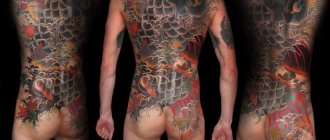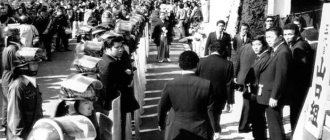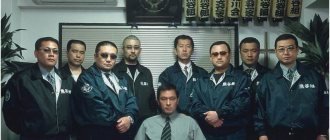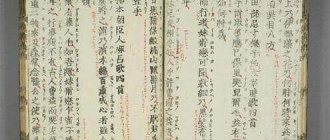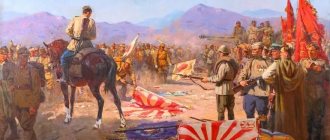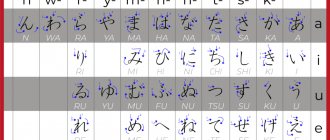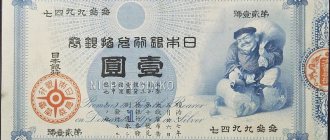Aristocratic clans of Japan
Japan is a country in which various clans have operated for many centuries, exerting a significant influence on the life of society at all stages of its development. Clans in Japan are Japanese aristocratic families whose houses had great influence; power over the entire Japanese state or over parts of it was concentrated in the hands of clan members. The most ancient genus is Gozoku. It was ruled by the Ujigami elders. There are mentions of this clan in several documents:
- Nihon seki lists (“the annals of Japan written with a brush”);
- Kojiki (“Records of Ancient Deeds”).
But gozoku lost their influence and political status until the beginning of the Heian period, which occurred from 794 to 1185. The Gozoku clan was replaced by a completely new aristocratic system - kuge. But their power did not last long: actual power at the end of the Heian period had already completely passed into the hands of several influential clans - the Buke samurai clans.
Help with student work on the topic Japanese clans
Coursework 460 ₽ Essay 250 ₽ Test paper 200 ₽
Receive completed work or advice from a specialist on your educational project Find out the cost
The imperial family in Japan are the supposed descendants of the five Japanese Vanir and rulers of Yamato. The period of their rule fell on the Kofun period. Emperors, as well as their relatives, fundamentally did not have surnames, but if necessary, the Japanese should have called them the “ruling clan” of the Axis. There were also four famous families in Japan:
- The Minamoto clan is best known as the Genji. This is a whole group that includes several clans from the times of ancient and medieval Japan. They were descended from the children of emperors, who were deprived of the status of princes and relegated to the category of subjects. The translation was made by providing the Minamoto surname (as we noted earlier, the emperors themselves could not have surnames). At first, representatives of the Minamoto clan had a prestigious status, and were also a very influential family; over time, they all turned into samurai and performed exclusively military tasks. From them come 21 branches of descendants of the first imperial house, including Go-Daino Genji, Go-Nijou Genji and many others;
- The Tyra genus is another genus that is better known as Heisi. They are the ancestors of four branches of the imperial house (Kammu Heishi, Koko Heishi, Montoku Heishi and Nimmyo Heishi);
- Tachibana clan - representatives of this clan are direct descendants of Prince Naniwa-o, who was the imperial son. At the same time, this is one of those clans that has nothing to do with the Tachibana samurai clan, which we wrote about just above;
- Fujiwara clan - representatives of this clan are descendants of Fujiwara no Kamatari. He was one of the most influential political figures, as well as a Yamato courtier.
Are you an expert in this subject area? We invite you to become the author of the Directory Working Conditions
Yakuza rituals.
Yubitsume , or cutting off fingers: According to this tradition, after the first offense, the offender cuts off the tip of the little finger from his left hand and hands the cut part to his boss.
Sometimes a clan boss may perform this ritual and give the cut off part of a finger to the oyabun when, for example, he wants to save one of his clan members from further reprisals. The origin of this custom comes down to the Japanese manner of holding a sword. The bottom three fingers of each hand are used to hold the sword firmly, with the index finger and thumb slightly relaxed. Removing the phalanges of the fingers, starting with the little finger, gradually weakens the grip on the hilt of the sword and the idea of punishment is thus that a person with a weak grip is only capable of defense.
Recently, prosthetic fingertips have been introduced to hide this feature, and when the British cartoon Bob the Builder was imported into Japan, plans were even made to add an extra finger to the characters so as not to scare small children. Many yakuza have tattoos all over their bodies, which are known as irezumi . Irezumi are still often pricked by hand, where the dye is injected under the skin using bamboo or steel needles. Such a procedure is not only painful and takes a significant toll on your pocket, it can also take more than one year to reproduce the entire pattern. While serving time in prison, some yakuza are immortalized every year with one pearl... inserted under the skin of the penis. And when the yakuza play cards with each other (Oicho-Kabu) , they often open their shirts or tie them around their waists, thus showing each other their tattoos. This is one of the few times when the Yakuza show their tattoos “in public”, because... As a rule, patterns are carefully hidden by highly buttoned shirts with long sleeves.
Another well-known ceremonial among the Yakuza is drinking sake together - thus sealing the fraternal oath between individual Yakuza or entire mafia clans. For example, in August 2005, Kenichi Shinoda and Kazuyoshi Kudo held such a ceremony, cementing the twinning of their clans - Yamaguchi-gumi and Kokushu-kai.zy.
The history of the emergence and development of the Yakuza.
The first historical background for their appearance is attributed to the hatamoto-yakko or Kabuki-mono of the 17th century, which are derived classes from the lower rank "hatamoto" . Other theories, proposed by members of the yakuza themselves, argue for their origins in the machi-yakko , who defended villages from hatamoto-yakko who, despite the strength and training of the machi-yakko, tried to plunder them. Despite their shortcomings, the Machi-yakko were regarded as folk heroes on the level of Robin Hood. The theory that the yakuza are descended from the hatamoto-yakko is due to the strange hair styles they adopted and the outrageous clothing worn by Kabuki actors during performances during the Genroku era.
Despite some differences of opinion, most researchers agree that most of the events associated with the emergence of the yakuza date back to the Edo period. Since at that time the Toyotomi Hideyoshi clan no longer threatened the power of the Tokugawa, peace reigned in the country and a huge number of soldiers were no longer needed to maintain general order and they moved to the castles of their daimyo.
Due to Japan's isolation and restrictions on foreign trade, its own trade and agriculture improved significantly, which led to the accumulation of power within the merchant class, and made the samurai dependent on them - the samurai's "wages" were paid in the form of a natural product - rice, which was then sold in local markets. Subsequent natural disasters, famine and increased taxes led to destabilization of society, a decline in morale and public discontent with the government. Then personalities such as ronin , who played a significant role on the historical stage of Japan. It was the ronins who moved from simply stealing money and violence to protecting villages from bandits and other bad people in return for a certain fee, of course.
Modern yakuza , however, claim that they came from the ranks of the mati-yakko, refuting their origin from the ranks of the hatamoto-yakko, because, you see, they [hatamoto-yakko] are associated with theft, which honest modern yakuza cannot afford . In large cities, several such groups often existed simultaneously and, as a result, competed for territory, money and influence - just like many modern gangs - ignoring any civilians who, by pure chance, found themselves in the line of fire. Again, the pioneer of the popular yakuza theme in Japanese cinema and television was Akira Kurosawa’s famous film “Yojimbo,” also in the West, in which a wandering ronin pits two yakuza factions against each other and ultimately destroys them. In fact, the yakuza received a little bit of both Machi-yakko (for example, some defense techniques) and Kabuki-mono (for example, frilly fashion and language) .
World of the Kingdom of Japan
Home » Alternative History - options for forks » World of the Kingdom of Japan
Alternate History - options for forks
boroda 01/07/2019 740
11
in Favoritesin Favoritesfrom Favorites 7
By the end of the 16th century, the lands of Japan were mostly united by the Christian samurai family (clan) Otomo, which accepted the title of kings (Japanese ou, port rei) of Japan from the Pope and the Portuguese Jesuits. During a fierce civil war that engulfed every province and every clan, Japanese lands were devastated and a significant proportion of the population died. However, after the end of hostilities, it was too early to talk about peace. King Joan (Yoshimune) imposed a new system of government and the Christian Catholic religion using cruel and violent methods, and suppressed any manifestation of dissent and disloyalty among the samurai. A huge number of clans were deprived of their own privileges and lands, and the expansion of the clans that supported Francis Sorin and the current king caused a surge of pride and narcissism among the nobility of these exalted families. The Christianization of the country was actively resisted by the peasantry and the Buddhist clergy; Japan was rocked by several bloody riots and rebellions (1587, 1596, 1597), which were brutally suppressed by the authorities. The Roman Church elevated the Christians killed during the pogroms to sainthood by a papal bull of 1620.
Even during the “Japanese Conquista” (Conquista no Nihon), Spanish “mendicant orders” (mendicanto orodé), competing with the Portuguese Jesuits, penetrated into Japan. The Spaniards managed to gain a foothold in the northern part of the island of Honshu, mainly thanks to the patronage of the royal “governor of the northern provinces” Alejandro Masamune from the Date clan. The son of the conquered Otomo daimyo Teremune, Alejandro went down in history as the patron of Catholicism and the colonizer of the northern Japanese lands, in particular, he founded Sendai Castle and built hundreds of churches on his lands and in the provinces of his vassal Mogumi clan. In Japanese historiography, it is widely believed that the Spaniards were able to play on the anti-Portuguese sentiments of the Date family, but the discussion on this issue is still ongoing[1]. The rapid expansion of the influence of the mendicant orders in the northeastern provinces led to a strain in Spanish-Portuguese relations in East Asia and laid the foundation for a split of the nobility into the “Portuguese Jesuit” and “Spanish Mendicant” parties.
In addition to reforms of the state apparatus, Joan also tried to pursue an active foreign policy at the instigation of the Jesuits, who were sincerely interested in expanding their missionary mission. The king's gaze was turned to the Korean coast. Money for the campaign was provided by Portuguese traders from India, impressed by the successes of the Conquest. The Imdin War began in November 1592. The large Japanese army, consisting mostly of poor landless samurai, easily defeated the Korean armies, which were inferior to the enemy in technological terms. At sea, the Japanese actions were supported by detachments of Wako privateers and mercenary Portuguese caravels. Thanks to the participation of the latter, the entire Korean fleet was burned in the naval battle of Busan, which secured the communications of Joan's army in Korea. By the end of the eight-month campaign, all of Korea, right down to the Jurchen lands, was under Japanese control. A full-scale guerrilla war broke out in the occupied territories, forcing Joan to scatter his forces to strengthen the garrisons.
The beginning of the end for the Japanese was China's entry into the war at the end of 1593. Concerned about the strengthening of the “southern barbarians” and the Christianization of Japan, Emperor Wanlu sent a huge army to help the Koreans. Japanese troops under Joan's command skillfully avoided major battles by retreating to the southern provinces. However, in the port cities besieged by the Chinese, a smallpox epidemic began, which killed a third of the Japanese army and a huge number of Koreans and Chinese. King Juan also died of smallpox, and the surviving Japanese forces were evacuated by sea to Japan.
The “mendicant samurai” who found themselves in their homeland without allotments, status, a penny in their pocket, and now even without the glory of winners, rebelled. The rebellion that engulfed Kyushu and the southern provinces of Honshu deprived the new king, Constantine (Yoshinobu), of the time and energy to negotiate with the Ming and the Koreans. Taking advantage of the established calm, the Chinese and Japanese sides tried to undermine each other's commercial maritime ties. Detachments of Japanese privateers regularly ravaged Chinese ports, and the Ming, in turn, made every effort to drag the island principality of Ryukyu into the war. Information about this did not escape the European intelligence network, and soon the Portuguese and Waco began to organize raids on Okinawa.
King Constantine, unlike his father, clearly understood that the war was ravaging and destroying Japan, and its continuation was in the interests of the Europeans, but not the Japanese. After the bloody suppression of the mendicanto busci revolt (1595), the king immediately resumed diplomatic correspondence with the Ming and set a date for negotiations for the spring of 1597. A few months before the arrival of the Chinese ambassadors, the Japanese-Portuguese fleet burned a large group of Ming ships, which allowed Constantine to reduce the result of the war to a draw - the Chinese emperor was disappointed in the idea of imposing vassalage on the Japanese. As a result of the Imdin War, Korea fell under the vassalage of the Ming dynasty, and Japan and Portugal received favorable terms of trade in specified Chinese ports.
After making peace, the king focused on rebuilding and developing Japan's economy. During the reign of Constantine, the period of the Iberian Union fell, the consequences of which the Japanese king successfully took advantage of. Deprived of financial support from Europe, the Portuguese colonies found a sponsor in the person of Constantine. In exchange for technology, knowledge, and art, the Japanese provided an economic base for the Europeans. In the period from 1594 to 1639, the Portuguese built dozens of manufactories, founded Kyoto University, and expanded ports on Kyushu and Shikoku. Domestic trade revived again, and the creative activity of Japanese writers, artists and poets resumed. A new cultural elite of the Japanese people was educated in parish schools and the university. The large-scale program for the development of the Japanese economy clearly symbolized Constantine’s belonging to the camp of the “Jesuits,” but his popularity among the common people did not allow the organization of noble conspiracies. In 1639, the Restoring King died of his own death at the age of 58, remaining in Japanese history under the nickname “The Peaceful Dragon.”
Constantine left behind seven sons - six of them married equally to brides from the “Jesuits” and “Franciscans” parties, the seventh, the eldest, remained a bachelor until his death[2]. The “lone king” (rei sabisi) Louis succumbed to the persuasion of the Portuguese to enter into confrontation with the Dutch. Satsuma samurai and ashigaru troops are recruited into the Portuguese forces and participate in the fighting in Formosa. During the reign of Louis, the fall of the Ming Dynasty and the Spanish-Portuguese War occur. Fortunately for the Japanese, the European war affected them only in the form of several bloody clashes between the “Jesuits” and the “Mendikans”. At the same time, receiving support from Japan, the Portuguese and Spanish force the Dutch out of the Chinese seas. By the middle of the century, the Jurchens (Manchus) finally conquered China. Refugees - Ming supporters - spontaneously fled to Formosa and besieged the Dutch fort of Zeeland, captured by the Spaniards. Negotiations with the Chinese commander led to peaceful Chinese settlement of the southwest of the island. The Kingdom of Formosa appeared on European maps.
With the death of Louis in 1669, the question of Japanese succession arose. The advantage in the confrontation between the “Spanish” and “Portuguese” parties was on the side of the latter - the southern provinces were more densely populated and developed, but the northerners had the initiative. In March 1670, the youngest son of Alejandro Masamune, Joan Munekatsu, daimyo from the Date clan, advanced from Sendai with a large army and besieged Kyoto and a number of fortresses in central Honshu. Such decisive actions took the “Jesuits” by surprise and pushed the northern nobility to fight. The outbreak of civil war was called by Japanese historians the “war of the princes” (sensou no souzocuzin). The first period lasted from 1670 to 1674. was a series of successful campaigns for the northerners. Many fortresses on Honshu were taken, Osaka was besieged and Kyoto capitulated, and in the summer of 1671, one of the sons of Louis from the camp of “mendicants” was crowned under the name Carlos. A year later, one of the southern princes (Joan Yoshihiko) also accepted the title of King of Japan, but the coronation was postponed until the return of Kyoto. Failures for the northerners began after the discord and subsequent split of the “Spanish” heirs into two camps, thanks to the tyranny of Carlos. The rebellion of a number of northern daimyo allowed the “Jesuits” to conduct a successful campaign of 1675-1676, as a result of which the central provinces were recaptured and the fortresses and ports of the northerners on the east coast of Japan were blocked from the sea. In the spring of 1678, Kyoto was recaptured, in the summer Carlos was killed by his own supporters, and the party of “rebel Mendicans” concluded a peace treaty with Joan II, which declared an amnesty for the northern nobility, guaranteed their noble privileges and rights, and also contained a number of regulations that actually created autonomy for the "Spaniards". By 1680, the last pockets of resistance from dissenting northerners were suppressed.
At the same time as the civil war in Japan, several small Buddhist uprisings occurred, as a result of which the last major sects were destroyed and their temples were burned. King Joan and the court believed, based on fragmentary information from the Principality of Satsuma, that the Buddhist rebels were sponsored by the Qing with the help of a smuggling network stretching from Chinese ports to Honshu through the Okinawa islands. With the help of the Wako pirate forces summoned by the king, Japanese troops landed on the Ryukyu Archipelago in 1683. After six months of the siege of Shuri Castle, the Ryukyuan van capitulated. From now on, Ryukyu recognized the power of the Japanese kings over itself, the activities of European and Japanese priests were allowed in Okinawa, and strict regulations were introduced for Chinese traders. It should be noted that sanctions were rarely used in East Asian trade - restricting and opposing market relations between Japanese, Korean and Chinese traders led to a worsening situation for everyone.
The policy of isolation in China, which had lasted for 45 years, led to friction between the Europeans and the government of the Qing dynasty. What especially cooled the relationship was the fact that the Spaniard was covered by the descendants of the Chinese pirate Koxinga, loyal to the Ming, who created their own state on Formosa. Regular sanctions imposed by the Qing on Japanese and European traders angered King Joan, who declared war on China in 1693 and landed in Korea. The Korean army was defeated in a series of short-lived battles; Wang Korea made a separate peace with Joan, for which he was soon arrested by Chinese troops. The Japanese, holding the initiative in the war, transferred the fighting to Chinese territory. In 1694, Ningbo and a number of coastal fortresses in Fujian province were taken, in 1695-96. The Japanese ravaged Canton and Kwanxi. Over the next five years, the Japanese ravaged and burned cities on the Shandong Peninsula, invaded southern Manchuria, but could not consolidate their success - this was facilitated by the huge number of Chinese troops and the mobilization resource of the Qing. The continued strategy of surprise attacks and devastation bore fruit over the next ten years. The Chinese embassy, which arrived at the place of negotiations - Ryukyu, agreed to Joan's conditions. The Treaty of Shuri (1711) allowed Christian missionaries to preach and build places of worship in Korea and the southern provinces of China, and the Qing emperors pledged not to impose any bans or sanctions against foreign trade.
The outcome of this war clearly showed that Japan - against the backdrop of the decline of Spain and Portugal as great powers due to wars in Europe and an unstable socio-economic situation - was seizing the role of the dominant power in East Asia. However, one should not exaggerate its strength and significance. The Kingdom of Japan was still a deeply feudal state in its structure, although with rare splashes of industrial industry in large port cities. Technical innovations came to Japan only with Europeans and their knowledge, although the process of replacing them with Japanese specialists had already begun. Not the least role was played by the Japanese kings, who progressively, although somewhat radically, implemented the technical modernization of Japanese statehood and society. Despite the actual dominance of Christianity, the Japanese managed to introduce into it their own national flavor and their own, purely Asian, understanding of the Gospel. Reading Portuguese scientific treatises, fighting with European firearms and attending church every Sunday, the Japanese still remained himself. The notorious colonization of Japan did not happen, with which pagan daimyos and Buddhist bosses threatened the hesitant. Japan slowly but surely, and on its own, was catching up with Europe in development.
Source - https://fai.org.ru/forum/topic/45175-kartyi-alternativnyih-mirov-chast-2/?do=findComment&comment=1521655
